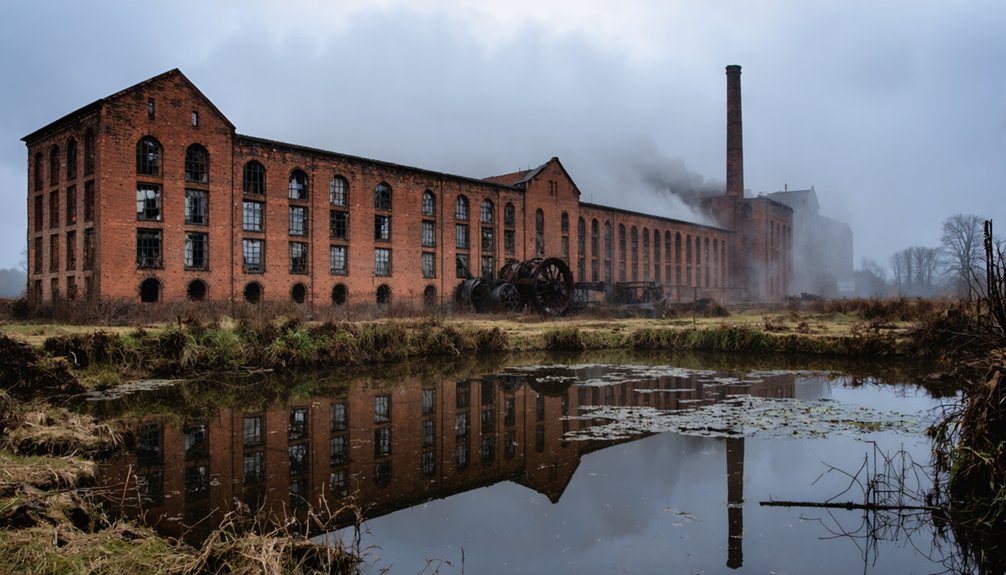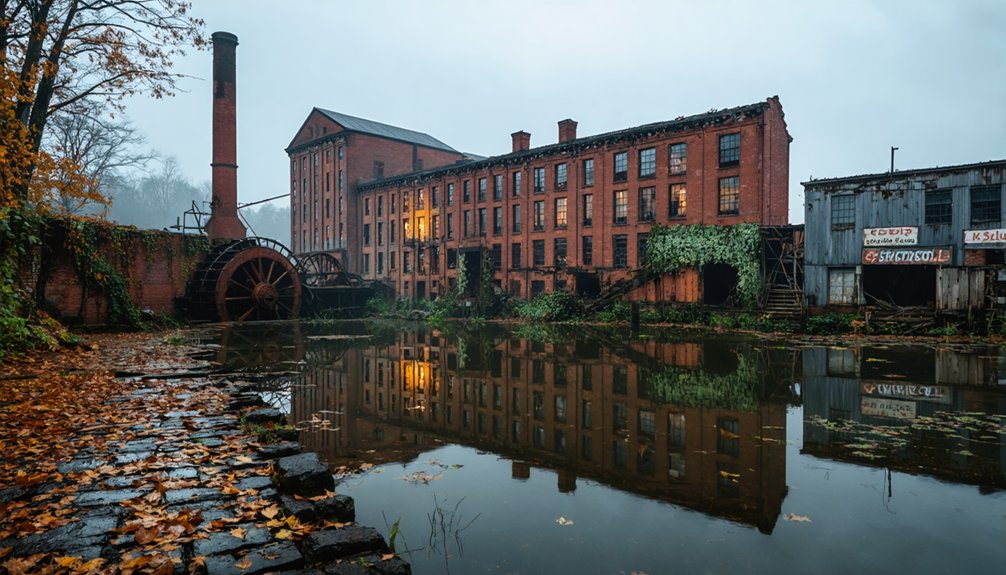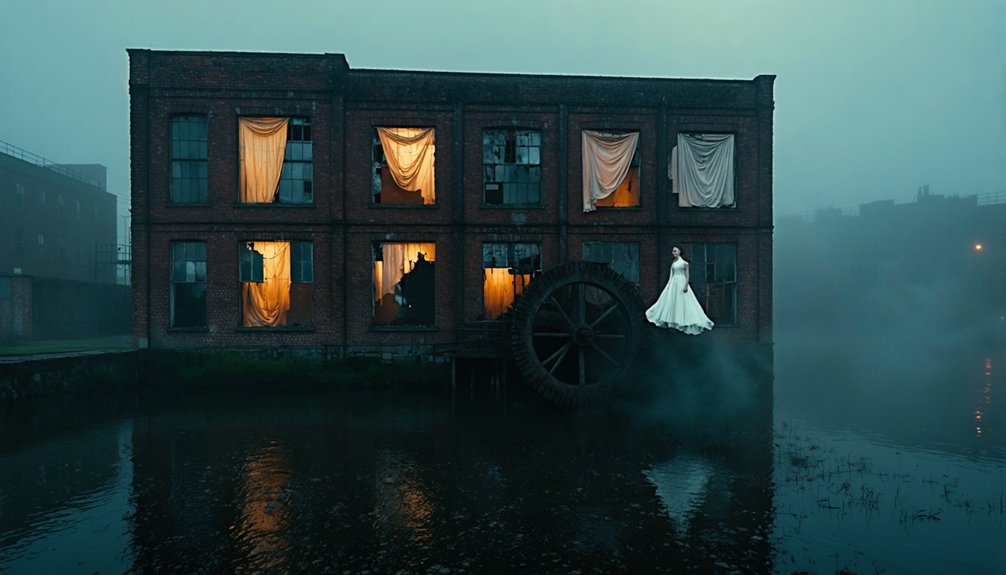You’ll find something eerily fascinating in America’s forgotten mill towns where spirits linger among rusted machinery. From Kennecott’s copper tower with its echoing miners’ wails to Terlingua’s mercury-poisoned souls, these seven haunted sites tell stories through supernatural encounters. Wander through Eckley’s immigrant-haunted homes, listen for Ironton’s spectral miners, or feel the chill near Fortson’s phantom lumberjacks. Each crumbling facade holds secrets waiting to be uncovered.
Key Takeaways
- Kennecott Mill Tower features ghostly miners’ wails and vanishing grave markers from its copper ore processing past.
- Eckley Miner’s Village houses immigrant spirits, cold spots, unexplained machinery sounds, and phantom knocking from coal mining days.
- Fortson Mill contains phantom lumberjacks with axes and eerie sounds from its once steam-powered operation.
- Terlingua’s mercury miners manifest as spectral figures with unexplained tremors and mysterious blue-silver orbs around abandoned rotary furnaces.
- Rhyolite’s Bottle House, built from 50,000 discarded bottles, contains whispers and strange encounters following its 1925 restoration.
The Haunted Mill Tower at Kennecott, Alaska
Standing tall against the rugged Alaskan wilderness, the Kennecott Mill Tower‘s weathered timber frame tells a story of industrial ambition and eventual abandonment that’ll send shivers down your spine.
Built between 1909-1923, this 14-story structure once processed copper ore from mines 4,400 feet above. The concentrator exemplifies turn-of-the-century mining technology that defined Western training camps of the era.
You’ll feel ghostly echoes of the past when visiting—miners’ wails still resonate through the empty corridors.
Local mining legends speak of vanishing grave markers along the old Copper River railroad and phantom tool sounds echoing inside the mill. Wildlife sometimes carries the spirits of those who never left. The railroad construction cost approximately $20 million to build despite treacherous conditions.
The tower stands eerily quiet now, but you can explore it yourself or join guided tours.
Just don’t be surprised if you’re not alone among the historic timbers.
Whispers From the Coal Face: Eckley Miner’s Village
You’ll feel a chill walking past Eckley’s red wooden-frame houses where immigrant spirits from diverse European backgrounds still linger, their whispers echoing tales of backbreaking labor and cultural resilience.
The film prop coal breaker stands like a monument to the tragic deaths that occurred in the real mines, with visitors often reporting cold spots and unexplained sounds of machinery where no equipment runs. This massive structure remains as tangible evidence of Paramount Pictures’ commitment to historical authenticity during the filming of “The Molly Maguires” in 1970. Archaeological discoveries throughout the site have uncovered children’s toys that reveal how the youngest residents found moments of joy amid harsh living conditions, providing a glimpse into their everyday lives.
Winter nights amplify the haunted ambiance as the hierarchical layout of this preserved patch town reveals itself—from the miners’ modest saltbox homes to the Gothic Revival house at the western end—each structure harboring its own ghostly residents who refuse to abandon the isolated village they once called home.
Immigrant Spirits Linger
While digging through the haunted history of Eckley Miner’s Village, you’ll find that immigrant spirits haven’t quite finished their earthly labor.
These coal-dusted phantoms bring their Old World ghostly traditions to Pennsylvania’s anthracite fields, where up to 30 souls once crowded into single company homes.
Listen carefully in the darkness and you’ll hear Cornish “Knockers,” Welsh “Coblynau,” or German “Berggeister” – supernatural beings from immigrant folklore that warned miners of impending danger.
Strange knocking sounds and floating lights aren’t just hallucinations born from underground anxiety; they’re the unfinished business of those who perished beneath the earth.
These spectral tales served as the true record-keepers in towns where company control extended from cradle to grave, preserving memories official histories conveniently forgot.
Many of these haunting narratives contribute significantly to mining community identity and help preserve the cultural heritage of those who lived and died in these dangerous conditions.
George Corson documented numerous accounts of miners encountering violent death apparitions throughout the Pennsylvania coal region during his folklore collection efforts in the 1920s.
Tragic Miner Hauntings
In the murky shadows of Eckley Miner’s Village, immigrant spirits have company. You’ll sense them immediately—spectral miners who never made it home, victims of Pennsylvania’s haunted tragedies that plagued coal country throughout the 19th century.
Walk these preserved streets during autumn’s fading light and you might glimpse what terrified Germantown residents in 1895 or the vanishing miner of Neshanic who sparked newspaper headlines across six Pennsylvania towns.
Locals once organized “ghost parties” at Taylor Mine where skeptics fled in terror when confronted with apparitions carrying picks and lamps.
These aren’t just campfire tales—they’re documented accounts that appeared simultaneously in publications from Scranton to Pittsburgh, revealing how industrial death transformed into enduring paranormal folklore that refuses to be silenced beneath the coal-dark earth. The historic 100 acres of Eckley preserves not just buildings and town layout from 1854, but the lingering memories of immigrant families whose stories echo through time.
Ironton’s Spectral Silver Miners
Three spectral figures haunt the windswept remnants of Ironton’s mining district, according to local lore.
Three ghostly miners wander Ironton’s abandoned streets, forever bound to the silver dreams that died with the town.
You’ll feel the spectral echoes of miners who once struck it rich in this boomtown that flourished after John Robinson’s 1882 silver discovery, then crashed following the devastating 1893 silver demonetization.
- Harry Larson, the stubborn miner who remained until the 1940s, still wanders through crumbling structures.
- Ghostly apparitions of sulfuric acid-burned workers appear near the corroded equipment they once operated.
- The final postmaster’s spirit reportedly sorts phantom mail in the collapsed post office.
- Milton Larson, the town’s last resident, keeps eternal vigil over his beloved mountain home.
- Spectral railroad workers labor endlessly on tracks long since removed.
Visitors often report feeling a chill when passing the ruins of twelve saloons that once served the town’s 320 residents during its heyday.
You’re witnessing freedom’s aftermath—where nature reclaims man’s ambitious folly and spirits refuse to abandon their silver dreams.
The eerie remains of Ironton are easily accessible to visitors, located just 150 yards east of Highway 550.
The Phantom Lumberjacks of Fortson Mill
Deep within the forgotten corners of Washington state, phantom lumberjacks still haunt the decaying remnants of Fortson Mill, once a thriving lumber operation along the North Fork Stillaguamish River.
You’ll find this forgotten mill, established in 1905 as McCaughey Lumber Company before George Fortson purchased it in 1914, has a turbulent history—devastated by fire around 1917 and ultimately dismantled by 1960.
Locals report spectral loggers wandering the abandoned grounds, wearing heavy boots and carrying axes—eternal reminders of the deadly hazards sawmill workers once faced.
These phantom sightings typically emerge at dusk, when shadows play across the ruins seven miles from Darrington.
Visitors exploring this industrial ghost town might glimpse these apparitions, forever working at dangerous jobs that claimed too many lives in the early 20th century. The ghosts are often seen near the concrete foundations where steam-powered machinery once drove the bustling operations of the mill.
Terlingua’s Mercury Poisoned Souls
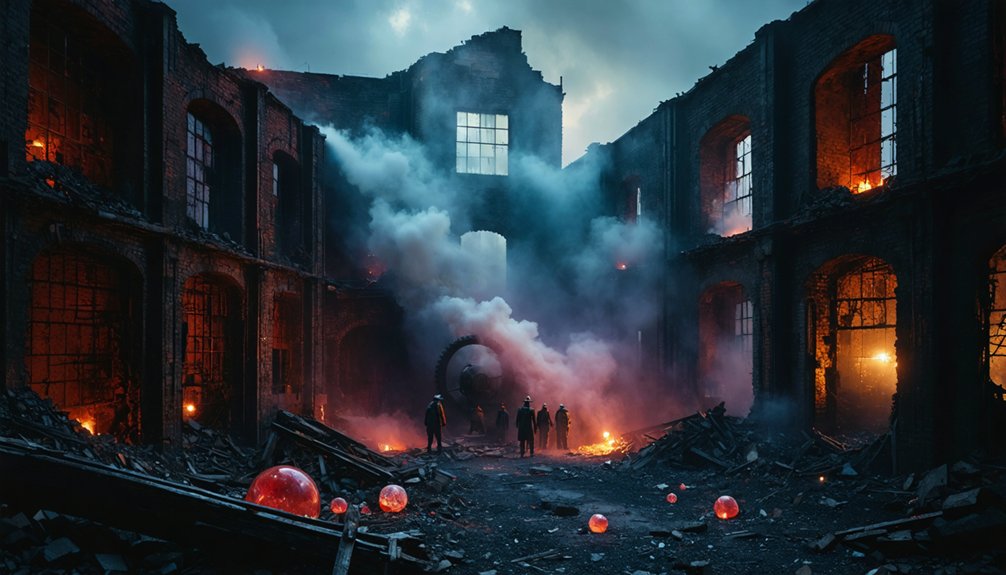
You’ll feel the whispers of quicksilver-poisoned miners when you visit Terlingua’s moonlit cemetery, where simple wooden crosses mark lives cut tragically short by mercury’s invisible grip.
The abandoned mine tailings still release toxic vapor into the desert air, an unsettling reminder of the price paid for America’s wartime mercury needs.
Locals swear that on quiet nights, the ghosts of those who died in their 30s and 40s—their minds and bodies ravaged by “salivation” and neurological decline—can be seen wandering among the ruins of what was once the nation’s largest mercury operation.
Quicksilver Miners’ Restless Spirits
When visitors wander through the crumbling remnants of Terlingua’s ghostly landscape, they’re rarely alone—at least according to local legend.
These quicksilver spirits are said to be miners who perished from mercury poisoning during the boomtown’s heyday, their souls unable to find rest.
You’ll hear tales of mercury hauntings from locals who swear the miners continue their work in the afterlife:
- Unexplained tremors—mimicking the shakes that plagued poisoned workers
- Spectral figures spotted near abandoned rotary furnaces at dusk
- Eerie sounds of pickaxes striking stone inside sealed mine shafts
- Cold spots felt near the cemetery where hundreds were buried
- Mysterious blue-silver orbs floating around the Chisos Mining Company ruins
Most died never knowing the true cause of their suffering—their bodies poisoned while earning a modest living.
Moonlit Ruins Whisper
Listen for spectral echoes near the cemetery’s handmade crosses, where over a century of souls rest beneath modest markers.
Moonlit encounters are common here, with visitors reporting whispers carried on desert winds.
The contaminated soil still releases mercury vapors, as if the land itself remembers the toxic legacy of the boomtown that once held 3,000 souls before becoming the ghost town you’re exploring tonight.
Mountain Top Mine: Ghosts Above the Clouds
Perched high in the mountains of Central Appalachia, Mountain Top Mine casts a long shadow over the valleys below—both literally and spiritually.
You’ll encounter what locals swear are spectral miners wandering the blasted ridge tops, their souls as unsettled as the disturbed landscape itself.
When you visit this massive operation—once owned by Patriot Coal before ERP Environmental Fund took over—you might experience:
- Ghostly apparitions with fatal injuries appearing near valley fills
- Mysterious knocking sounds echoing from abandoned shafts
- Floating lights that drift above reclaimed slopes at midnight
- Whispered warnings said to come from Cornish “Knockers”
- Cold spots that mark sites of forgotten mining accidents
These phenomena connect to West Virginia’s tragic mining history, where disasters claimed hundreds of lives and created a legacy that refuses to stay buried.
Rhyolite’s Bottle House: Where Spirits Never Leave
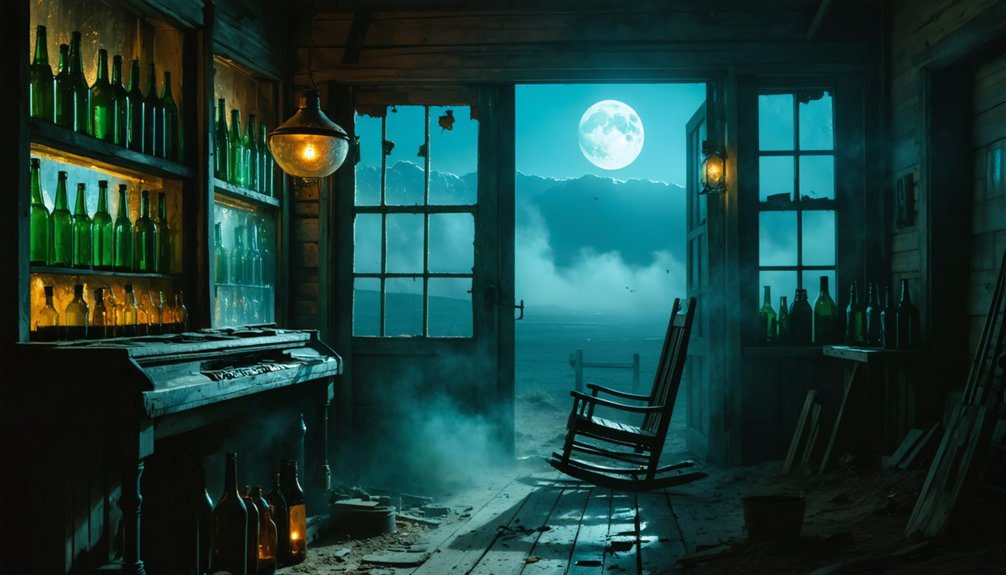
Standing in the Nevada desert like a shimmering mirage, Rhyolite’s Bottle House captures both sunlight and souls within its glassy walls. Built in 1905 by resourceful stonemason Tom Kelly using 50,000 discarded bottles, this three-room home represents the ultimate act of desert freedom and ingenuity.
You’ll feel the weight of history as you approach this masterpiece of Bottle Architecture—where whiskey, beer, and medicine vessels form walls that have outlasted the boomtown itself.
After the Bennett family left in 1914, Desert Spirits seemingly moved in. Since Paramount Pictures restored the roof in 1925, visitors have reported strange encounters inside this glittering relic.
Whispers among the glass walls tell of shadowy figures who found sanctuary where bottles hold more than emptiness.
Whether you’re drawn by its architectural uniqueness or tales of lingering ghosts, Tom Kelly’s creation stands as Rhyolite’s most enduring monument to mankind’s resourcefulness.
Frequently Asked Questions
Do Spirits Follow Visitors Home From Abandoned Mining Towns?
Restless souls typically don’t hitch a ride home with you. Research shows spirit attachment after visitor experiences is rare—most ghosts stay put where their earthly struggles ended, bound to their final resting places.
Can Paranormal Activity Increase During Specific Weather Conditions?
Yes, you’ll notice ghostly phenomena often escalate during storms, foggy nights, and dramatic weather patterns. Your senses become more attuned when barometric pressure drops, making the unseen world surprisingly accessible.
What Safety Precautions Should Ghost Hunters Take in Deteriorating Structures?
Keep your eyes peeled! You’ll need a buddy system, reliable flashlight safety equipment, helmets, and sturdy boots. Never disregard structural integrity warnings—those rickety floors ain’t playing around with your safety.
Have Any Ghost Town Apparitions Been Scientifically Documented?
You’ll find no scientific documentation of legitimate ghost sightings. What you’re callin’ apparition evidence typically boils down to natural phenomena—carbon monoxide, infrasound, or your brain’s tendency to create patterns from nothin’.
Are Hauntings More Common in Towns With Tragic Endings?
Text me this: yes, when you’re exploring towns with tragic endings, ghostly legends flourish like Instagram trends. Research shows places with emotional or violent historical significance—mines closing, epidemics, violence—consistently generate more paranormal reports than peaceful settlements.
References
- https://albiongould.com/ghost-towns-to-visit-in-the-states/
- https://www.haunted-britain.com/ghost-stories.htm
- https://www.visitouray.com/ghost-towns
- https://www.gothichorrorstories.com/real-ghost-stories/
- https://www.christywanders.com/2024/08/top-ghost-towns-for-history-buffs.html
- http://etd.auburn.edu/bitstream/handle/10415/3237/Leah W Craig Thesis.pdf.txt?sequence=5&isAllowed=y
- https://stateofwatourism.com/ghost-towns-of-washington-state/
- https://whyhorror.blog/2020/09/11/why-30-haunted-places/
- https://en.wikipedia.org/wiki/Ghost_town
- https://katiestringerclary.com/2012/10/30/ghosts-and-historic-sites/
